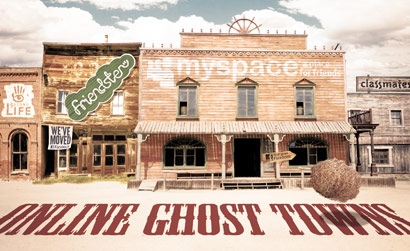
 LiveJournal
LiveJournal
What the heck was that?
When the history of the social network is written (not by screenwriter Aaron Sorkin), it may show Mark Zuckerberg’s whole “I’m in college and want a way for other college kids to communicate” was thought up years prior by Brad Fitzpatrick. He developed the concept a decade ago, when LiveJournal was born out of a need to keep in touch with friends. “Way before blogging was fashionable, millions of users were sharing their lives and making friends on LiveJournal,” says Sue Rosenstock, the site’s director of communication.
If you were showing up for homeroom in 1999, there’s still a good chance you or someone in your age group had an account on LiveJournal, if for no other reason than to tell the world what mood you were in. Pessimistic? Naughty? Aggravated? Then get on LiveJournal, combine a colon with an open parenthesis and tell the world. By 2005, 5 million people were covering LiveJournal pages in emoticons.
What happened?
That same year, Fitzpatrick sold Danga, the company he created that owned LiveJournal, to Six Apart. Six Apart is responsible for a pair of fairly popular blogging platforms—Movable Type (open-source, geared to developers) and TypePad (closed but customizable, geared to end-users). Six Apart posted a lengthy message on its blog (aptly titled “Current Mood: Optimistic”) hashing out details of the acquisition.
By and large, the purchase seemed to make plenty of sense—uniting several blogging platforms under one company. And during the time LiveJournal was under the Six Apart umbrella, the idea worked, with the number of accounts growing from 5 million to 14 million. By 2007, both its traffic and userbase were peaking.
But two years after it purchased LiveJournal, Six Apart sold the site in 2007 to SUP, a Russian media conglomerate. A year prior, it had paid to license LiveJournal in its home country. SUP’s move was a head-scratcher, as it had no prior existence in the social networking space. People began to wonder how freedom of speech, a freedom enjoyed by LiveJournal users, would fare under Russian ownership.
But the events were already set in motion for LiveJournal to be eclipsed. As LiveJournal was sold to Six Apart in 2005, MySpace was scooped up by Rupert Murdoch and News Corp., giving Tom and co. more resources than they knew what to do with. And during LiveJournal’s two years of ownership by Six Apart, Facebook made two of the decisions that would ultimately allow it to leapfrog everything in its path—in 2005 it launched a version of the site for high school, and in 2006 it opened the doors to any and everyone with an e-mail address. Add in tiered accounts, several of which cost money, and there was more going wrong for LiveJournal than was going right.
Where is it now?
LiveJournal is currently the eighth most-trafficked site on the Internet—in Russia. The site also continues to expand in other countries outside the U.S., Rosenstock says, and touts 30 million users worldwide. One of its communities, a celebrity gossip group called Oh No They Didn’t, received so many comments it literally knocked the site down for a week. On our shores, it has conceded a large chunk of its market share to Facebook, Twitter and MySpace. (Its Alexa.com ranking is 117th in U.S., 74th globally.) Rosenstock points to a fundamental difference between LiveJournal and those competitors: “While MySpace, Facebook, and Twitter revolve around short status updates, our users share deep content, posting to their journals and to communities to share common passions,” she says. Don’t think LiveJournal has forgotten what truly made it great—moods. It now offers mood themes, a market which houses 132 types of moods for your page.
 Bebo
Bebo
What the heck was that?
A UK-based, blog-centered social network, made in 2005 when everyone else in the world was also making a social network. In its features and appearance it’s essentially forgettable amidst all the others, except for the fact that it exploded in the UK and Ireland. In 2006, according to The Guardian, it was the fastest growing website in the world. In 2008, founders Michael and Xochi Birch sold the site to AOL for $850 million—and like the Friendster and Classmates.com founders before them, it was just in time.
What happened?
Bebo’s trajectory is probably the most absurd picture of the social network boom and bust. Only two years after the $850 million purchase, AOL just sold Bebo for $10 million. That is a preposterous 99 percent loss of capital, a scale of failure made possible by the utter confusion of a new industry. “Bebo came out of the gates in January of 2005 when this stuff was just going mad,” Wired writer Clive Thompson points out. “It was the perfect time for a large company that was totally confused about its direction—AOL—to sort of scoop something up.” For a while Bebo maintained a stronghold in Ireland not dissimilar from Friendster’s in Asia, but this also fell apart at the end of 2009 (it’s now only the 50th most visited site in Ireland, and the 1,112th in the world).
Where is it now?
It is the prime example of an online ghost town. AOL left it to its own devices, and now it’s a sort of accidental museum to its own over-complicated, eye-assaulting layout. Its pages are full of increasingly desperate ads targeting an increasingly non-existent audience. Most of the Irish profiles show a sudden, un-discussed abandonment in the late fall of 2009, just like Friendster’s in Asia (final, unanswered Bebo comments include: “in greece ! how are youu …” and “How’s u today pal?”).



